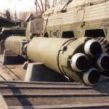
MOSCOW PUTS PR SPIN ON ITS SHRINKING NUCLEAR ARSENAL
Publication: Eurasia Daily Monitor Volume: 3 Issue: 74
By:

Russia will complete the modernization of its land-based and sea-based strategic missiles in 2015-2020 and plans to deploy up to 2,000 nuclear warheads as prescribed by the current arms control treaties with the United States. That was the main message from a rare public statement by Yuri Solomonov, the general designer of the euphemistically named Moscow Thermal Technology Institute, which is the main Russian research center on missile technologies. Except for the reassurance that the financing of these programs from the state budget was secured, he did not break any news but nevertheless made many headlines (Izvestiya, Rossiiskaya gazeta, Gazeta.ru, April 14).
Commentators interpreted this assertive message as a response to the article, “The Rise of U.S. Nuclear Primacy” by Keir A. Lieber and Daryl G. Press in the March issue of Foreign Affairs that exploded like a bomb in the Russia’s higher political circles (Nezavisimoe voennoe obozrenie, March 31; Vedomosti, March 22). The argument in the article is hardly new: The quantitative decline and qualitative degradation of Russian strategic forces create a situation where they could be completely obliterated by a first, “disarming” U.S. strike. Whether this crucial threshold in the strategy of nuclear deterrence has already been crossed or will be in the near future is essentially an academic question, but the fact of steadily increasing U.S. superiority is beyond doubt.
These elementary calculations make a devastating contrast with the many loud statements from the Russian leadership on the invulnerability of the strategic “shield.” Defense Minister Sergei Ivanov has just delivered another one, marking his five years on the job (Vremya novostei, March 29). President Vladimir Putin probably feels that his trademark praise for Russian ultra-modern missiles that could puncture any strategic defense system has been seriously undermined and so, against expectations, he did not show up at the recent annual meeting of Armed Forces officers (Ezhednevny zhurnal, April 6).
Solomonov, hard as he tried, was not able to disprove the conclusion about the fundamental inadequacy of Russia’s strategic forces. His main proposition was that, according to the new state program on strategic armaments that will be adopted in the coming months, the land-based Topol-M intercontinental ballistic missile (ICBM) would be equipped with the same multiple warheads as the sea-launched Bulava ballistic missile (SLBM) (Kommersant, April 14). That might indeed help in preserving the high total count of the warheads but would not resolve the accumulating problems with the delivery systems. As Alexei Arbatov pointed out, the current production scale of six-to-eight Topol-M missiles a year is about four times lower than what is necessary for replacing the old Soviet ICBMs that are still in service, besides being economically inefficient for the Votkinsk plant (Lenta.ru, April 14). The much-advertised Bulava still needs many more tests before it could be ready for deployment in the new generation of nuclear submarines; very optimistic plans aim at equipping the Yuri Dolgoruky, the first sub of the Borei class, by the end of this decade, and that essentially means that for the next five years the naval leg of Russian nuclear triad will continue to rely on the SLBMs that are long past their expiration date (Izvestiya, March 15).
Such “bean-counting” has always been a favorite pastime of strategic experts but, as Pavel Podvig points out, numbers of warheads and delivery systems now matter far less than the assessment of readiness and reliability of the command-and-control systems (Vedomosti, April 14). Most of these systems, designed on the basis of communication technologies of the pre-computer age, are now hopelessly outdated, but one mechanism that is maintained in perfect order no matter what is the fool-proof system for preventing an accidental launch. As for the early warning, there has been for years much talk about new radar stations that are still yet to be erected, but last week provided an opportunity to reflect upon satellites and space stations.
April 12, 1961, was a day of undiluted joy when the whole USSR celebrated the first space journey and first learned the name of the man would remain loved for generations: Yuri Gagarin (Vremya novostei, April 12). If Russia needs a day of national unity and patriotic pride, this is certainly it. President Putin marked the 45th anniversary by organizing a direct TV link between the Kremlin and the International Space Station and even accepted an invitation to visit the facility (Newsru.com, April 12). His main concern, however, was about building a Russian system of global navigation (GLONASS) that would provide more reliable service than U.S.-controlled global-positioning satellites (Kommersant, April 13). One part of the problem is that it requires the integrated work of 24 satellites, but Russia now has only 12 in operational status, while too many space launches last year were unsuccessful, resulting in the loss of commercial satellites.
A larger part of the same problem is that space research in Russia cannot advance as a narrow and isolated sector while most other high-tech industries are in decline. The over-concentration of resources in the energy complex that underpins Russian clams for the status of “energy super-power” leads to stagnation in industries that are not serving the development of hydrocarbons. Russia cannot emulate the Soviet model where oil money was pumped into the production of armaments, not least because there are too many greedy bureaucrats that have other plans for this money. Hence the pre-determined delays and setbacks in both advancing the space program and modernizing the nuclear arsenal. The Soviet research base– and Solomonov’s institute is a perfect example — continues to have difficulties in absorbing information technologies that require different organizational structures. Far greater difficulties exist in disposing of many products of previous research. One particular issue here that requires massive collective efforts is elimination of thousands of warheads from the often-neglected tactical nuclear weapons inventory. The developing Iran crisis could be a reminder about the urgent need in re-launching arms-control talks.




